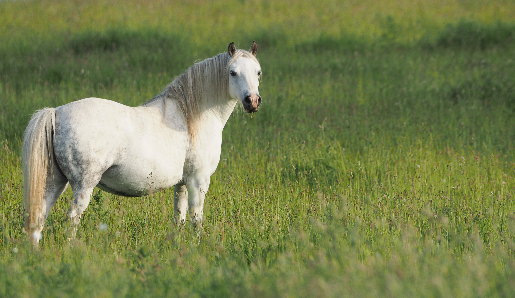When your horse eats, its digestive tract breaks down the protein, fat, and carbohydrates into smaller pieces that can be absorbed. For carbohydrates, the smallest units are simple sugars such as glucose. Insulin is released from the pancreas after a meal to help transport glucose from the bloodstream into cells and tissues where it can be used. However, some horses do not respond properly to the effects of insulin. This condition is known as Insulin Resistance (IR) in horses.
A related condition is high levels of insulin in the blood or Hyperinsulinemia (HI). The combination of insulin problems, obesity, and pockets of “lumpy fat” on the body makes up Equine Metabolic Syndrome, putting horses at risk for laminitis.
Diagnosing insulin resistance in horses
Unfortunately, many horses are only diagnosed with IR or EMS once they develop laminitis. Early signs that your horse may be losing his sensitivity to insulin include:
- Chronic or recurrent lameness that is mild, seasonal, and makes it seem like your horse is “walking on eggshells”
- A tendency to be overweight or obese, even when on limited food (the “easy keeper”)
- Fatty deposits in key areas of the body, including the crest of the neck, the rump and tail head, behind the shoulder, in the sheath or mammary gland, and above the eye socket
If you think your horse has any of these signs, contact your veterinarian. They will perform a physical exam and specific bloodwork to test for EMS. Based on your horse’s age, breed, and signs, your veterinarian may also test for Cushing’s Disease. Known as Pituitary Pars Intermedia Dysfunction, PPID is a related but separate condition that may also lead to laminitis.
What should I do if my horse is insulin resistant?
Based on your horse and its situation, your veterinarian will advise you on the best ways to care for them. The key areas of concern are diet and exercise.
Diet
In terms of diet, there are two main goals: 1) weight loss if the horse is overweight or obese, and 2) keeping the NSC level below 10%. NSC stands for Non-Structural Carbohydrates, which includes sugars, starches, and fructans. Horses with Insulin Resistance don’t do well with too much sugar and starch in the diet, so experts recommend avoiding feedstuffs with high levels of these. This usually means no grain (swap for a ration balancer or multi-vitamin) and no pasture (at least at first). Later, your horse may be able to graze at certain times of day wearing a muzzle to restrict how much grass he eats. Hay will need to be analyzed, weighed, and possibly soaked so that you’re providing the right amount of the safest kind of hay.
Exercise
If your horse is sound, your veterinarian will most likely recommend daily exercise. Research suggests 15 minutes of trotting 5 days a week (under saddle or in hand) improves insulin sensitivity and encourages weight loss. Of course, if your horse is not used to this much exercise, you should gradually build him up to it. Unsound horses or those currently having a bout of laminitis should only be exercised under the direct care of a veterinarian.
How do I prevent insulin resistance in my horse?
Insulin Resistance and Equine Metabolic Syndrome are more common in certain breeds:
- Ponies (and possibly donkeys)
- Spanish breeds (e.g. Andalusians)
- Gaited breeds (Saddlebreds, Paso Finos)
- Morgans
- Miniature horses
- Warmbloods
However, just because a horse is considered “at-risk” for IR and EMS doesn’t necessarily mean they will develop it. It is the combination of genes and management that causes signs to appear. That is, if your pony is kept at an ideal body condition score of 5 with a sensible diet and thoughtful exercise program, they may never show signs of insulin resistance or laminitis. But ahorse with no history of EMS in their family may show signs if overfed grain and hardly worked.
Is there a role for supplements in insulin resistance?
Since grain is off limits for EMS horses, nutritionists advise giving a ration balancer or multivitamin to meet daily nutrient requirements. In addition, some experts recommend ingredients such as magnesium, chromium, resveratrol, omega 3 fatty acids, and others to help support a healthy metabolism. Antioxidants like vitamin E are also commonly suggested.
Summary
Some horses do not respond properly to insulin, a condition which is called Insulin Resistance. IR and other problems with insulin, lumpy pockets of fat, and obesity are risk factors for laminitis. Together, these signs are known as Equine Metabolic Syndrome. Certain breeds are more prone to EMS but a low-sugar diet and regular exercise may lower your horse’s risk for this condition and for laminitis.


